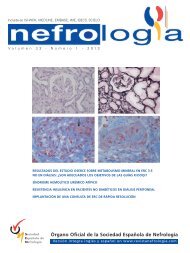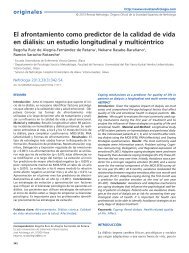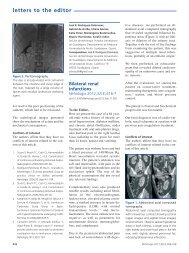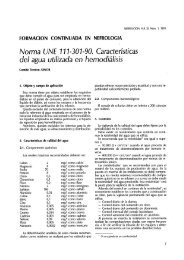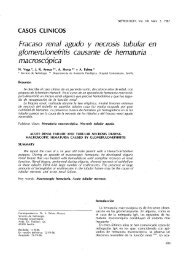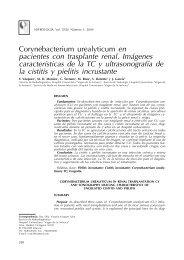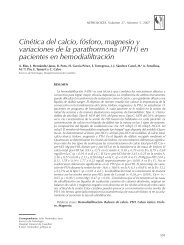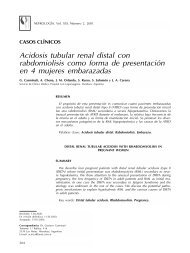PDF Número - NefrologÃa
PDF Número - NefrologÃa
PDF Número - NefrologÃa
You also want an ePaper? Increase the reach of your titles
YUMPU automatically turns print PDFs into web optimized ePapers that Google loves.
evisiones cortas<br />
http://www.revistanefrologia.com<br />
© 2011 Revista Nefrología. Órgano Oficial de la Sociedad Española de Nefrología<br />
Arterial calcification: cardiovascular function<br />
and clinical outcome<br />
G.M. London<br />
INSERM U970, Paris and Hopital F.H. Manhès. Fleury-Mérogis (France)<br />
Nefrologia 2011;31(6):644-7<br />
doi:10.3265/Nefrologia.pre2011.Oct.11175<br />
ABSTRACT<br />
Arterial calcification (AC) is a common complication<br />
of CKD and ESRD, and the extents of AC are predictive<br />
of subsequent cardiovascular mortality beyond established<br />
conventional risk factors. AC develop in two distinct<br />
sites: the intima and media layers of the large and<br />
medium-sized arterial wall. These two forms are frequently<br />
associated. AC is tightly associated with aging<br />
and arterial remodeling, including intima-media thickening,<br />
but also changes of the geometry and function<br />
of aortic valves. Evidence has accumulated pointing to<br />
the active and regulated nature of the calcification process.<br />
Elevated phosphate and calcium may stimulate sodium-dependent<br />
phosphate cotransport involving osteoblast-like<br />
changes in cellular gene expression. AC is<br />
responsible for stiffening of the arteries with increased<br />
left ventricular afterload and abnormal coronary perfusion<br />
as the principal clinical consequences.<br />
Calcificación arterial: la función cardiovascular<br />
y el resultado clínico<br />
RESUMEN<br />
La calcificación arterial (CA) es una complicación común en la<br />
enfermedad renal crónica y la enfermedad renal en etapa terminal,<br />
y cuyo alcance es diagnóstico de una posterior mortalidad<br />
cardiovascular más allá de los factores de riesgo convencionales<br />
establecidos. La CA se desarrolla en dos ubicaciones<br />
diferentes: en las capas íntima y media de las paredes arteriales<br />
de gran y medio tamaño. Estas dos formas se encuentran<br />
frecuentemente asociadas. La CA está estrechamente relacionada<br />
con el envejecimiento y el remodelado arterial, que incluye<br />
el engrosamiento de la íntima-media y los cambios en la<br />
geometría y la función de las válvulas aórticas. Se han recogido<br />
evidencias que señalan la naturaleza activa y regulada del<br />
proceso de calcificación. Elevados niveles de fosfatos y calcio<br />
pueden estimular el cotransporte de fosfato dependiente del<br />
sodio que implique cambios osteoblásticos en la expresión genética<br />
celular. La CA es responsable del endurecimiento de las<br />
arterias, con un aumento de la poscarga ventricular izquierda<br />
y perfusión coronaria anormal como principales causas clínicas.<br />
Keywords: Arterial calcifications. Arterial stiffness.<br />
End-stage renal disease.<br />
Palabras clave: Calcificación arterial. Rigidez arterial.<br />
Etapa final de enfermedad renal.<br />
INTRODUCTION<br />
The cardiovascular complications are leading cause of<br />
mortality and morbidity in chronic and end-stage renal<br />
diseases, in great part related to arterial diseases, i.e.<br />
atherosclerosis and arteriosclerosis 1,2 . While atherosclerosis<br />
and plaque-associated occlusive lesions are the frequent<br />
causes of these complications, arteriosclerosis is<br />
characterized by outward remodeling and stiffening of large<br />
arteries 3 . These arterial structural and functional changes are,<br />
Correspondence: Gérard London<br />
INSERM U970, Paris and Hopital F.H. Manhès.<br />
Fleury-Mérogis. France.<br />
glondon@club-internet.fr<br />
in many aspects, similar to an accelerated age-related<br />
process 3 . One characteristic feature of arterial alterations<br />
observed in renal patients is the presence of extensive<br />
vascular calcifications 4-6 whose extents are predictive of<br />
subsequent cardiovascular mortality beyond established<br />
conventional risk factors 7-9 . AC develop in two distinct sites:<br />
the intima and media layers of the large and medium-sized<br />
arterial wall 10 . These two forms are frequently associated.<br />
Intima calcification occurs within atherosclerotic plaque and<br />
is a progressive feature of common atherosclerosis, while<br />
media calcifications can occurs independently from<br />
atherosclerotic plaques and is frequently observed in<br />
medium sized arteries in CKD/ESRD, diabetes. AC is tightly<br />
644



